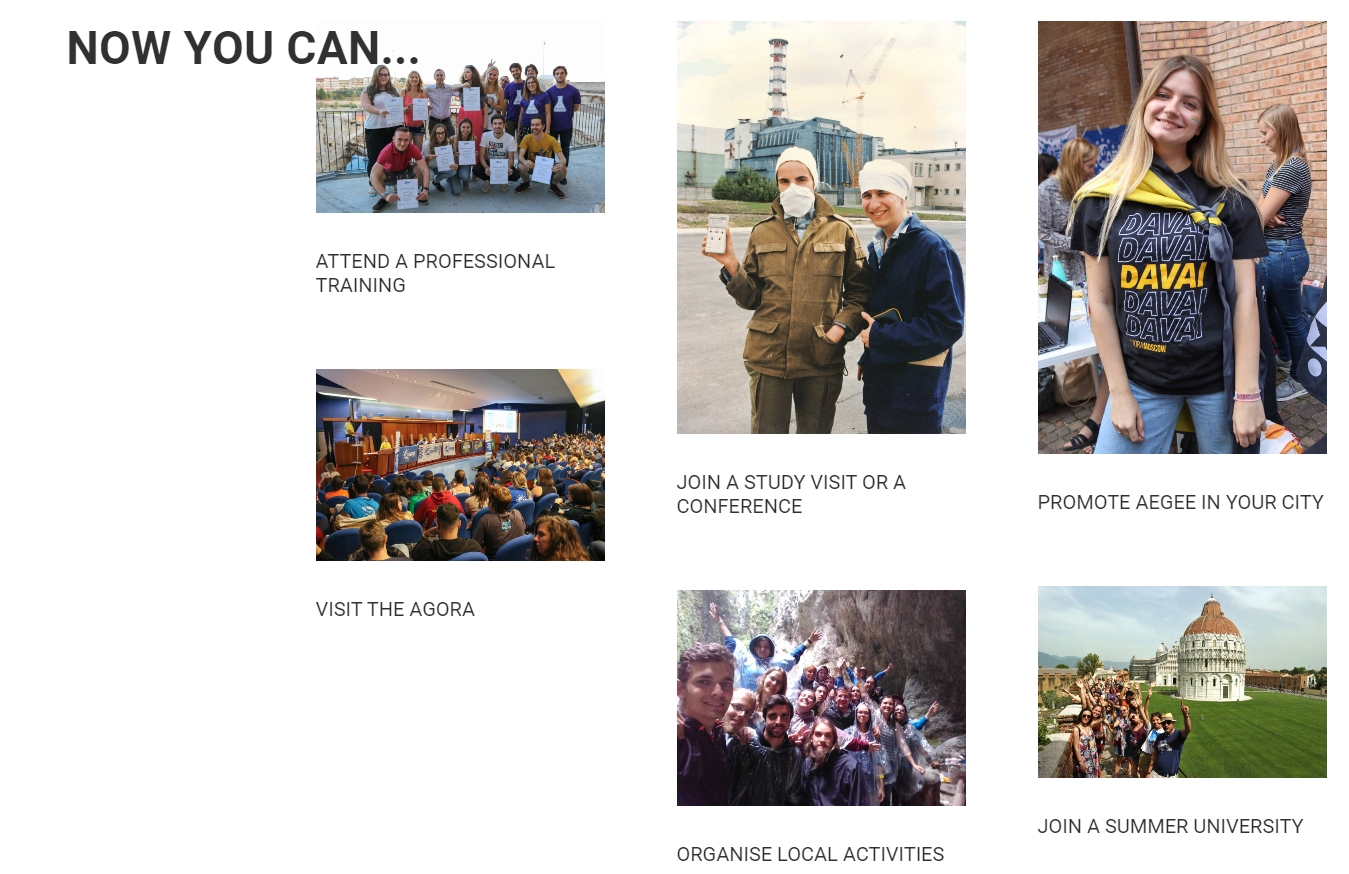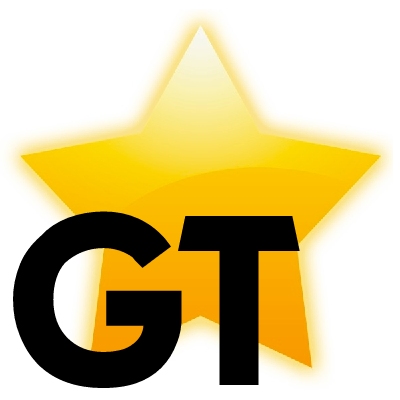I published the following article in November 2019, highlighting several obstacles which made it hard for interested people to become an AEGEE Contact. As a result of this article, the procedure has greatly improved.
For example, interested people had to download a PDF motivation letter, which they had to print out, scan and send back. This document had eight pages. Now it is just three pages, of which the first one is the cover page. The required information is easier to get. And it is a Word document, not a PDF anymore.
The required support letter was another obstacle, because it meant that the university was offering a lot of services to an unknown bunch of people. The support letter has been rephrased and is much more appropriate in style and content now. Moreover, the AEGEE homepage now says: “If you cannot get a support letter for some reason, contact the Network Director to explain the situation and ask how to proceed.” Also here, AEGEE-Europe shows a lot for flexibility and makes it easier to found a new Contact.
Just one thing remains: the steps to register a Contact are still hidden on the bottom on the link “For students”. Direct links like “Join AEGEE” and “Found AEGEE” right on the top of the homepage would surely be a better solution.
Nevertheless, I am happy that this article was useful in making the procedures for registering Contacts easier. Thank you, CD!
In the following you will find the original article.
AEGEE does not really make it easy to found a Contact, which is the first step to sign the Convention d’Adhesion, like AEGEE-Lefkosia just did (see photo above). The information for founding a Contact is not easy to access and not very attractive. An experiment.
Yesterday I was talking to two people on messenger. Both of them are already active members, both of them were thinking about creating new Contacts – and both of them had questions about it. This led me to the thought: isn’t all the info easy to access and presented in a catchy manner on the AEGEE-Europe homepage?
The answer: there is room for improvement.
So I had a look and made a little protocol. This is not meant as ctiticism towards anyone wctive right now in the CD or any other body. Sometimes simply things get neglected that are not in our daily view – and active people can forget to see AEGEE with the eyes of a non-member.
1. Looking on the AEGEE homepage
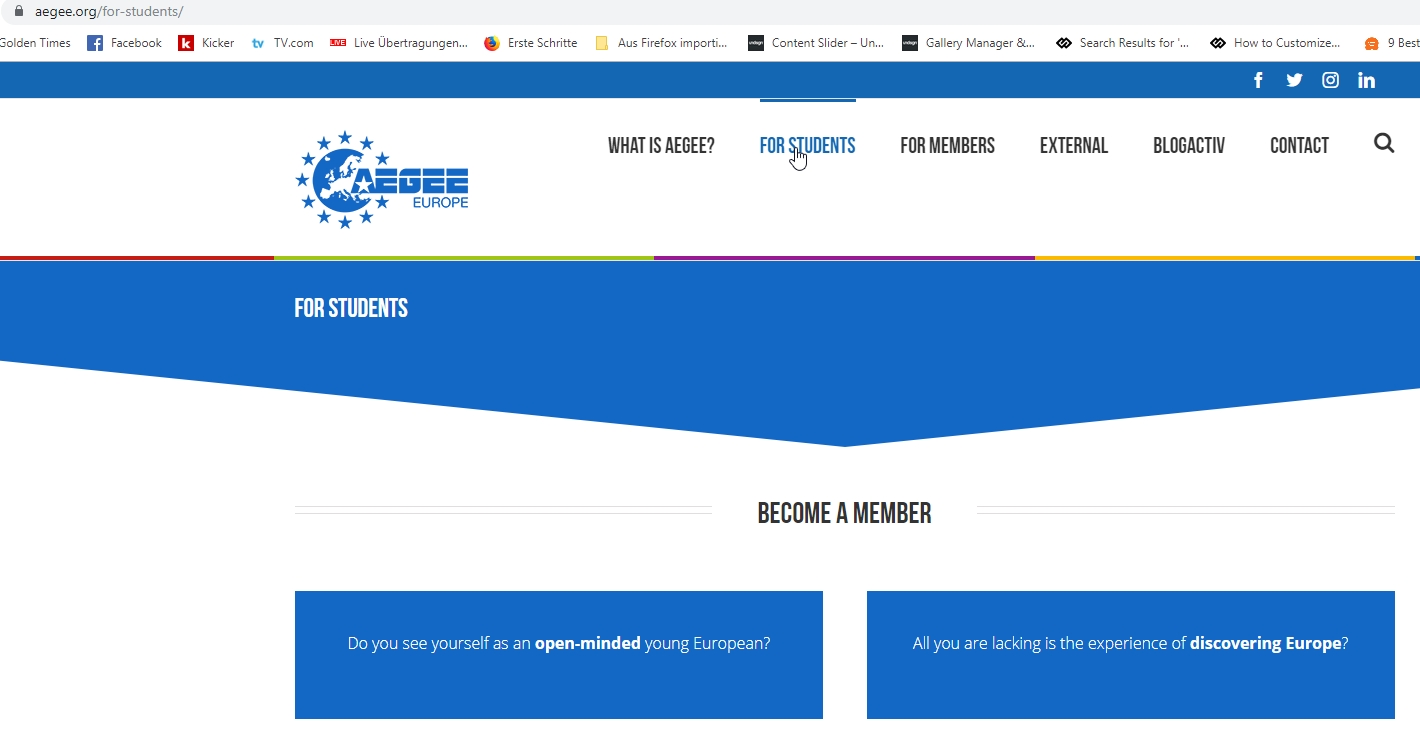
When you go to the AEGEE-Europe homepage aegee.org, you won’t find info on founding a local on the startpage. Unfortunately, there is not even a “Join AEGEE” button. This is actually a step back towards older version of the website – in 2004 for instance you had a “Find AEGEE in” dropdown menu as well as a subscription field to the monthly Calendar of Events newsletter. Well, at least it’s quite intuitive to go to the menu item “For students”. Unfortunately, other than all other menus, this one does not expand into links like “Become a member”, “Find a local” or “Found a local”, because it’s all on one page. There, on the bottom, under the nice headline “Find AEGEE close to you” and the unfortunately non-zoomable and therefore not that useful map of locals, you find the headline “Found an AEGEE local”.
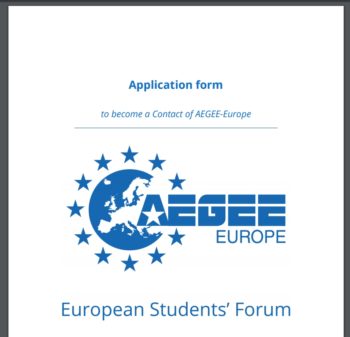 Let’s not go into the fact that “local” is only in AEGEE English the term for a branch or local chapter, whereas it usually designates a local person. There is actually a really nice motivating paragraph that encourages people to create a Contact. There is also a very nice three-step overview on how to establish a Contact. Textwise it’s really good.
Let’s not go into the fact that “local” is only in AEGEE English the term for a branch or local chapter, whereas it usually designates a local person. There is actually a really nice motivating paragraph that encourages people to create a Contact. There is also a very nice three-step overview on how to establish a Contact. Textwise it’s really good.
There is also a link to a motivation letter and here I was a bit surprised. This document has eight pages, of which the actual motivation letter has less than one page. There are several pages about the university and studies in general, such as “Educational System: Are you under Bologna process? What general obligations exist on attendance of classes?” or “Role of the student council in the university”. That’s all nice to have, but is it really necessary in this step? Isn’t it more important that the person finishes this form instead of doing research that might make him lose his motivation? Most of this info can be asked in a later step by AEGEE-Europe and has nothing to do with the motivation. It looks more as if AEGEE wanted to make an encyclopedia about universities.
What’s worse: it’s a PDF. Well, PDFs can be editable, but this one is not. This means: if someone is interested in founding a Contact, he or she needs to print that out, fill the info in, scan it and then send it as attachment. All eight pages. Why not reducing it to the basic info and motivation and turn it into an online application form?
Also a Support letter by the university is required, but there is no sample letter linked. Instead, at the very bottom of the page, under the formal three-step programme, you find the link to a “Contacts Toolkit” with the remark to read it carefully.
I did. Although it wasn’t easy. The Contact Toolkit is a file in the online publishing platform ISSUU. And: it’s not possible to download the PDF. So you can only read it as e-paper, which is not really the best way to make appetite for reading a brochure with 20 pages. Anyway, there, on page 5, in the last row, I found a link to a sample support letter!
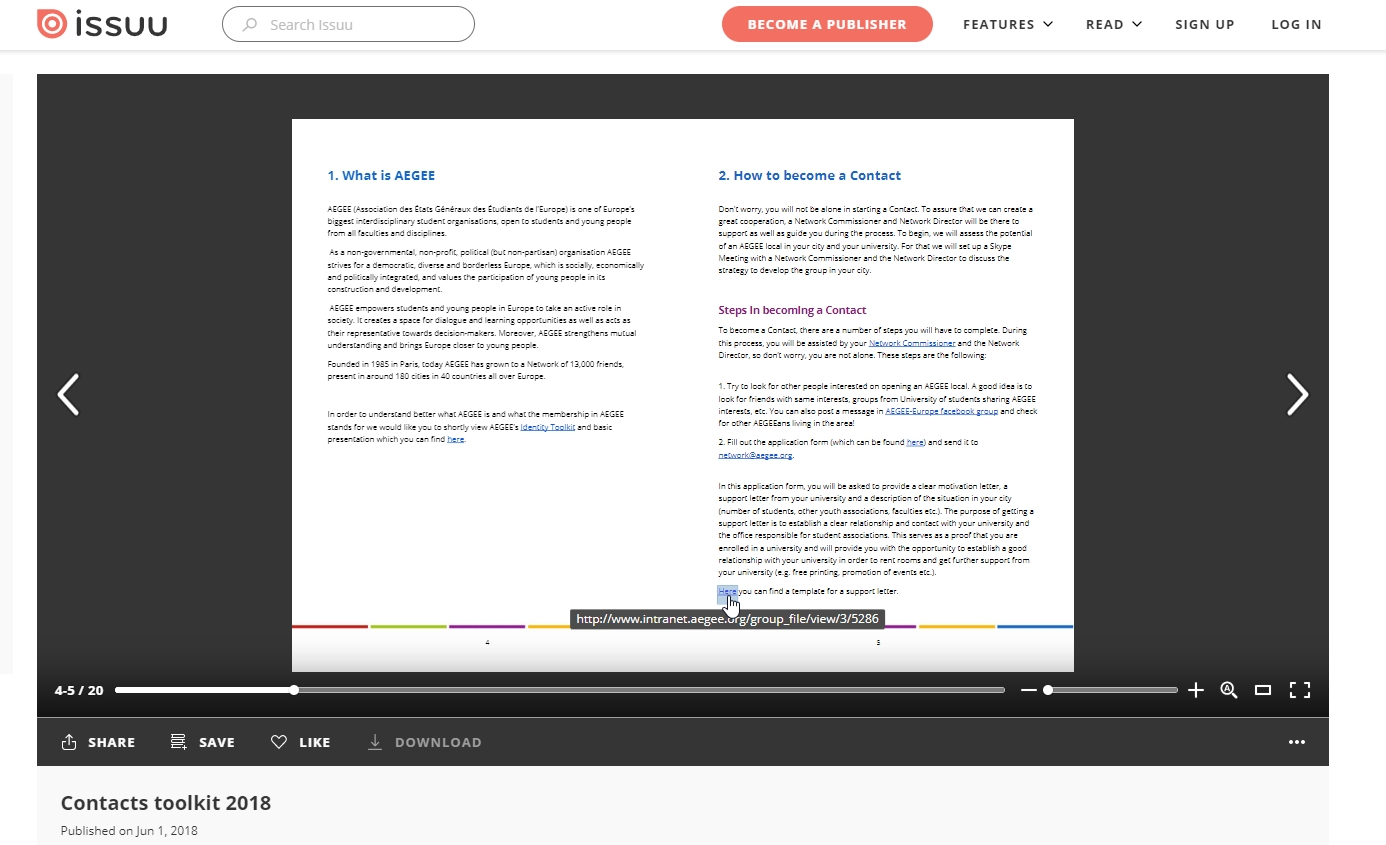
What a relief! Just imagine someone who does not have any experience…
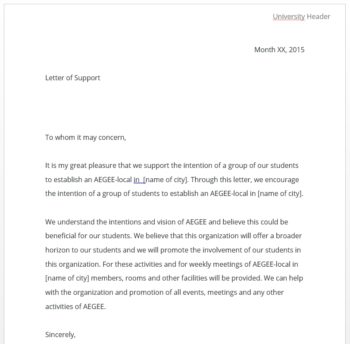 The support letter is a Word document in English. AEGEE might consider updating it, because it still has the date 2015 inside and mentions several times “AEGEE-local” in the text and not “AEGEE Contact”. So the university is not required to support the Contact, but a potential Contact Antenna? Now let’s look at the text about the commitment that the university has to make:
The support letter is a Word document in English. AEGEE might consider updating it, because it still has the date 2015 inside and mentions several times “AEGEE-local” in the text and not “AEGEE Contact”. So the university is not required to support the Contact, but a potential Contact Antenna? Now let’s look at the text about the commitment that the university has to make:
“we will promote the involvement of our students in this organization. For these activities and for weekly meetings of AEGEE-local in [name of city] members, rooms and other facilities will be provided. We can help with the organization and promotion of all events, meetings and any other activities of AEGEE.”
Now that is interesting, The university commits itself to provide members. So the dean forces them? Maybe forcing the freshers? Also, the university might have concerns about possible financial commitments coming from the promises. The dean might also ask what “other facilities” are. Maybe it’s better to correct and simplify this letter.
So, after compiling all these info it is finally actually possible to submit the founding request with the help of a Podio form.
2. Using Google
In case you don’t find your way through the jungle of the AEGEE-Europe homepage, but want to google the information, you will stumble upon something interesting. If you search for “Founding an AEGEE local”, “Founding an AEGEE Contact” or “Founding AEGEE”, the top result is not the post above, but a separate post called “Founding an AEGEE Local“. However, it is not directly connected to AEGEE.org – you cannot find the link, neither on the main page nor in the “For students” section. It is probably an older version of the current post. Obviously the link to “Founding an AEGEE Local” was deleted, when the page was changed. But then the question is why? And if you think it was done because the article was not necessary anymore, why keeping the disconnected detailed description online at all?
Now let’s look at that post.
The good news is that it is far more detailed and precise than the post above. It is really excellent content! Ok, there is some random code inside like, but this won’t keep anyone from continue reading. This post has the link to support letter and motivation letter – and this time the motivation letter is a Word document! Awesome! The only thing I can criticise here is the fact that Tekla Hajdu ist still mentioned as Network Director. This shows that the number one Google hit for this topic has not been updated since 2016 or 2017.
Small addition, for sake of completeness: there is a third article about this topic, this time in the Members Portal. Under the headline Antennae Criteria you will find the basic requirements.
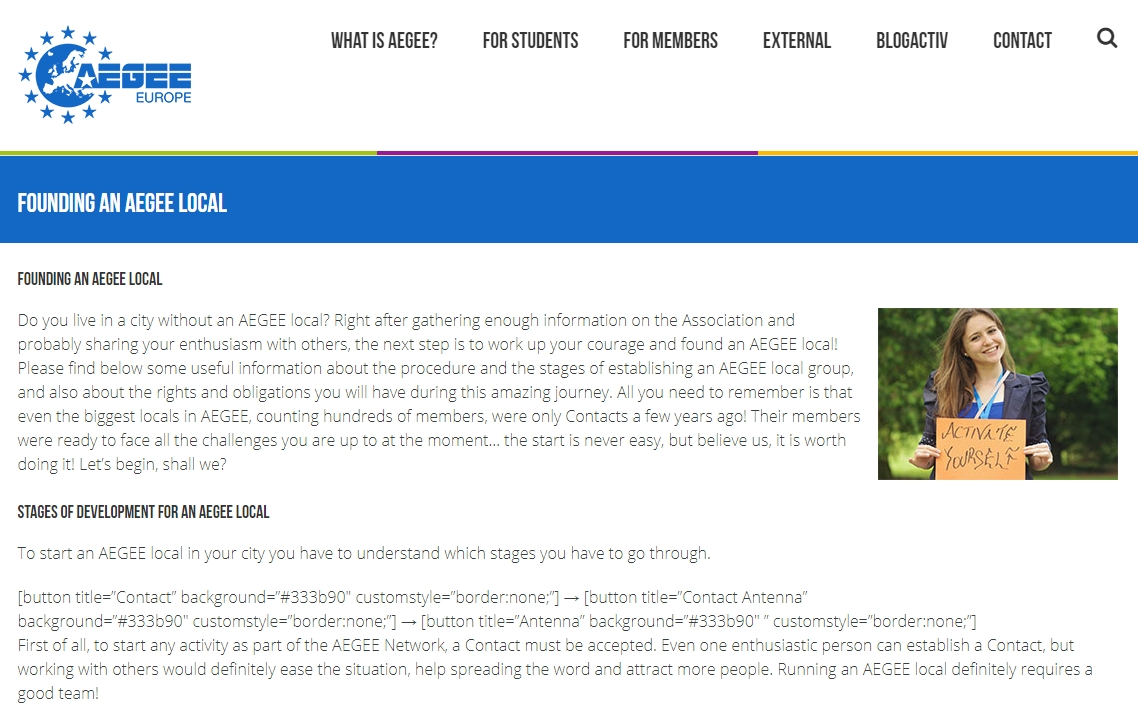
3. Room for improvement
After describing the content on the website let’s look at it with the eyes of a non-member, who stumbled upon AEGEE and wants to create a Contact. Are the pages above really making appetite to become a founder? I think there is room for improvement. For this I have to give an example from politics.
You may have heard what happened in German politics five months ago. The Youtuber Rezo created a video with the title “Die Zerstörung der CDU” – the “Destruction of the German Christian Democrats”. You might agree with the content of the video or not, but more than 16 million people watched it. 228,000 people commented on it. The German CDU, in power since 2005, was helpless. They did not know how to react. They simple did not have the necessary social media competence. One of their parliamentarians suggested to reply in kind with a Youtube video. However, that idea was dropped and replied with a 12-pages PDF. I had to think of that when I saw then no-downloadable 20-page Contact Toolkit…
This leads me to a couple of questions:
- Where are the “how-to” videos in AEGEE, where are the doodle videos that are currently so popular? Where are the video interviews with antenna founders? Well, they are not on the AEGEE-Europe homepage and not on the AEGEE-Europe Youtube channel. Such videos would be great to have if we are serious about network enlargement. We need to make founding a Contact easy.
- Aside from videos, AEGEE can also create a slideshow or series of photos that can be used for different platforms like Instagram or Facebook. We have to bring the message to the people!
AEGEE definitely has to be there where the potential members are – und use the most appropriate tools. The reason is simple: even if the website is nice, too many people are used to visual input. Also a nice video could be good how an antenna developed from humble beginnings to great success.
These are actually hard to find on the Internet and we should consider making them. Here are a couple of very rudimentary videos, made by some antennae for a workshop about local antenna history that I gave four years ago in Warsaw.
But even beyond videos, where are the emotional or informative photos, where are the success stories, the “founders of AEGEE” posts and articles? Non-existing. The new article has zero pictures and zero examples, the older article has at least two random photos in thumbnail size of people holding signs with “Activate Yourself ” and “European friendship”.
In my opinion this is not sufficient. Because like this we underestimate the power of positive examples. When I made my first Key to Europe, the previous editor-in-chief gave me just one advice, but it was a good one: “People want to read about people”.
4. Let’s start working on it
Well, it’s one thing to analyse a problem but another to offer a solution. I could not come up with a video or slideshow in a few hours, but I could create a simple website, using mainly the texts from the existing website, just working a bit on a more visual presentation. It is far from perfect, but food for thoughts. If you can come up with a better solution, thenm it’s awesome! You can find the result here.
